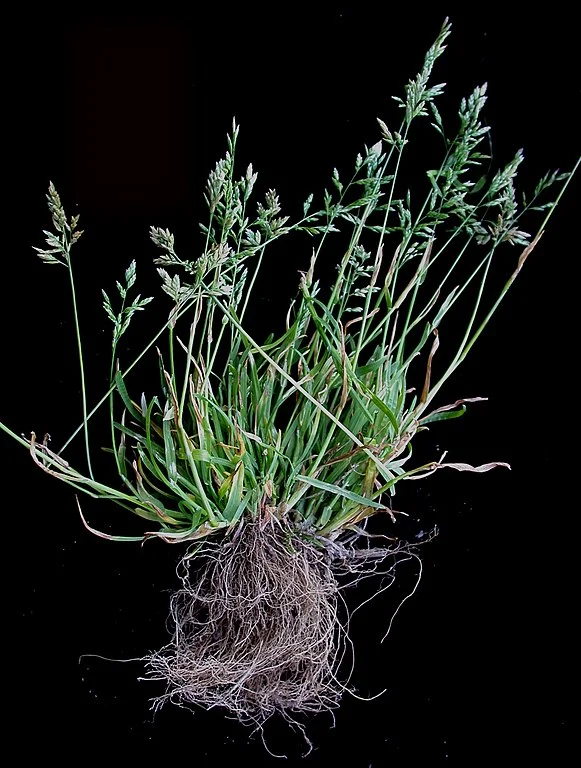Annual Bluegrass (Poa annua) is a species of herbaceous, tufted grass that spreads quickly. It is known for composing pastures, ornamental lawns, and as a challenging weed in certain situations. Originating from Europe, this grass has found its way across almost all continents, adapting to a variety of habitats, from renowned golf courses to residential gardens.

Native to Europe, Annual Bluegrass has naturalized in many other regions, including Brazil. This cosmopolitan species tends to thrive in places with shade and fertile, cool soils. Its adaptability is so remarkable that it has even been recorded in remote locations like the South Shetland Islands in Antarctica and the subantarctic islands of Australia. The name Poa comes from Greek, referring to a type of meadow grass, while annua is a Latin word meaning ‘annual’ or ‘lasting for a year’. This name reflects its typical life cycle, although there are biotypes of the species that are perennial.
Its stems are cylindrical, slightly compressed, with well-marked nodes, and can grow both upright and creeping. The leaves, thin and soft, often feature transverse wrinkles, with flat leaf blades ranging from 2.8 to 10 cm (1.1 to 3.9 inches) in length. The ligule is a distinctive aspect – membranous and oblong, differing from other grasses of the same genus, like the Kentucky bluegrass (Poa pratensis), which has a square ligule. Its roots are strong, fibrous, and abundant. Flowering begins in winter and extends through spring. Its inflorescence is an open, pyramidal panicle, with lower branches arranged in pairs, and the spikelets, containing 3 to 5 flowers, disarticulate upon maturation, a key mechanism in the dispersal of its seeds. Annual Bluegrass is easily distributed by wind, but also through contact with tools, contaminated inputs, equipment, vehicles, and the footwear of people moving through the garden.
Although often considered a weed, Poa annua has its uses. It is an effective forage and aids in soil stabilization, especially in areas where the top fertile soil layer has been removed. In temperate climate countries, such as the United States, where it is known as annual bluegrass, it is cultivated as a lawn, offering dense, high-quality turf, particularly for golf courses.
Annual Bluegrass prefers soils rich in organic matter, with good fertility. It thrives in conditions of constant moisture, preferably in soils that are neither dry nor waterlogged, and in places that offer partial shade, although it can tolerate a wide range of sunlight exposure. The plant develops best in mild temperatures, typical of temperate climates, and is quite versatile regarding soil pH, growing well in slightly acidic to neutral soils.
Additionally, Poa annua often benefits from soil disturbances, such as those caused by gardening activities or earth movement, which can expose seeds to ideal germination conditions. The plant is also notable for its ability to compete with other species for resources, especially in lawns or gardens, where it can quickly establish itself in disturbed areas or where other plants have been removed.
In lawns and gardens, Annual Bluegrass can become a problem, particularly in cooler climate regions, like the south of Brazil during winter. Its tendency to form clumps can interfere with the uniformity and aesthetics of ornamental lawns. It also tends to infest flower beds and paths, occupying spaces from between pavers to narrow spaces along walls. Controlling Poa annua requires a broad approach. In lawn production areas, the application of pre-emergent herbicides at the beginning of winter can prevent seed germination. However, once germinated, eradication becomes more challenging. Different products, in a sequence of applications, may be necessary to gradually eradicate the infestation. In golf courses and residential gardens where the use of pesticides is limited or prohibited, manual removal may be the only viable option.


